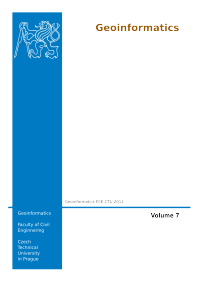Possibilities of contactless control of web map applications by sight
DOI:
https://doi.org/10.14311/gi.7.5Keywords:
Eye Tracking System, Web Map Applicatons, SensoMotoric Instruments (SMI), non-contact controlAbstract
This paper assesses possibilities of a new approach of control map applications on the screen without locomotive system. There is a project about usability of Eye Tracking System in Geoinformatic and Cartographic fields at Department of Geoinformatics at Palacky University. The eye tracking system is a device for measuring eye/gaze positions and eye/gaze movement ("where we are looking"). There is a number of methods and outputs, but the most common are "heat-maps" of intensity and/or time. Just this method was used in the first part, where was analyzed the number of common web map portals, especially distribution of their tools and functions on the screen. The aim of research is to localize by heat-maps the best distribution of control tools for movement with map (function "pan"). It can analyze how sensitive are people on perception of control tools in different web pages and platforms. It is a great experience to compare accurate survey data with personal interpretation and knowledge. Based on these results is the next step – design of "control tools" which is command by eye-tracking device. There has been elected rectangle areas located on the edge of map (AOI – areas of interest), with special function which have defined some time delay. When user localizes one of these areas the map automatically moves to the way on which edge is localized on, and time delay prevents accidental movement. The technology for recording the eye movements on the screen offers this option because if you properly define the layout and function controls of the map, you need only connect these two systems. At this moment, there is a technical constrain. The solution of movement control is based on data transmission between eye-tracking-device-output and converter in real-time. Just real-time transfer is not supported in every case of SMI (SensoMotoric Instruments company) devices. More precisely it is the problem of money, because eye-tracking device and every upgrade is very expensive. This constrains and their solutions are also discussed in paper. Main aim of the project is to design (both economically and technologically), optimal way how to record and convert eye-movement in a program with sophisticated control of movements.References
BIEDERT Ralf, BUSCHER Georg, DENGEL Andreas (2009): The EyeBook – Using Eye Tracking to Enhance the Reading Experience. In: Informatik-Spektrum, Vol. 33, Nr. 3, 2010, pp. 272 – 281.
BRODERSEN Lars, ANDERSEN Hans, WEBER Steen (2002): Applying eye-movement tracking for the study of map perception and map design. Kort und Matrikelstyrelsen, Denmark, Publications Series 4, Vol.9., 98 pp.
BRYCHTOVA Alzbeta, POPELKA Stanislav, VOZENILEK Vit (2011): The analysis of eye movement as a tool for evaluation of maps and graphical outputs from GIS. In: Proceedings Geografie a geoinformatika – Výzva pro praxi a vzdělávání, Brno, 9 pp. In print.
COLTEKIN Arzu A. et al. (2009): Evaluating the Effectiveness of Interactive Map Interface Designs: A Case Study Integrating Usability Metrics with Eye-movement Analysis. In Cartography and Geographic Information Science, Vol. 36, No. 1, pp. 5-17.
CUTRELL Edward, GUAN Zhiwei (2007): What are you looking for? An eye-tracking study of information usage in web search. In Proceedings of the SIGCHI conference on Human factors in computing systems, San Jose, California, USA, 10 pp.
DUCHOWSKI Andrew T. (2007): Eye tracking Methodology, Theory and Practice. Springer – Verlag London Limited, 2007, 321 pp.
GIENKO Gennady, LEVIN Eugene (2005): Eye-tracking and augmented photogrammetric technologies. In: Proceedings ASPRS 2005 Annual Conference, Baltimore, Maryland, 8 pp.
GOLDBERG Joseph H., KOTVAL Xerxes P. (1999): Computer interface evaluation using eye movements: methods and constructs. In International Journal of Industrial Ergonomics, Vol. 24, pp. 631-645.
FISHER Danyel (2007): Hotmap: Looking at Geographic Attention. In IEEE Transactions on Visulization and Computer Graphic, Vol. 13, No. 6, pp. 1184 – 1191.
CHAMPION, E (2011).: Virtual Environments. Playing with the Past, Human-Computer Interaction Series, London.
KÖRDNIG Konrad, KAYSER Christoph, BETSCH Belinda, KONIG, Peter. Non contact eye-tracking on cats. Institute of Neuroinformatics, ETH/Uni Zürich. doi:10.3929/ethz-a004266375.
LI Xia, COLTEKIN Arzu A., KRAAK Menno-Jan (2010): Visual Exploration of Eye Movement Data Using the Space-Time-Cube. In Geographic Information Science, Lecture Notes in Computer Science, Vol. 6292/2010, pp. 295-309.
NOURDEIN B., LAWRENCE P.D., MAN C.F. (2005): A non-contact device for tracking gaze in a human computer interface. In: Computer Vision and Image Understanding – Special issue on eye detection and tracking, Vol. 98 Issue 1, 31 pp.
RAIHA Kari- Jouko et al. (2005): Static Visualization of Temporal Eye-Tracking Data. In Human -computer Interaction – INTERACT 2005, Lecture Notes in Computer Science, Vol. 3585/2005, pp. 946-949.
STEINKE Theodore R. (1987): Eye movement studies in cartography and related fields. In Cartographica: The International Journal for Geographic Information and Geovisualization, Vol. 24, No. 2, pp. 40 – 73.
Downloads
Published
Issue
Section
License
- Authors retain copyright and grant the journal right of first publication with the work simultaneously licensed under a Creative Commons Attribution License that allows others to share the work with an acknowledgement of the work's authorship and initial publication in this journal.
- Authors are able to enter into separate, additional contractual arrangements for the non-exclusive distribution of the journal's published version of the work (e.g., post it to an institutional repository or publish it in a book), with an acknowledgement of its initial publication in this journal.
- Authors are permitted and encouraged to post their work online (e.g., in institutional repositories or on their website) prior to and during the submission process, as it can lead to productive exchanges, as well as earlier and greater citation of published work (See The Effect of Open Access).

